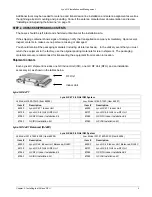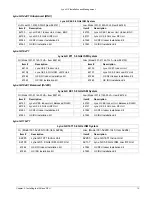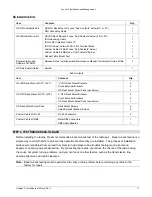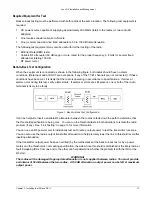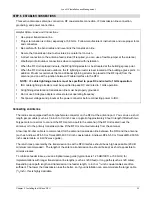
Lynx.GX Installation and Management
Antenna Cabling Guidelines for 5.8 GHz Units
▪
Coaxial cables of
7
/
8
-inch or larger diameter can exhibit moding at 5.8 GHz and are never recommended.
Also, some small diameter cable types, such as RG-8 or LMR-400, will have high loss or poor VSWR at
these frequencies. If small diameter cables are required, be certain to keep the lengths of these cables as
short as possible and always properly terminate these cables.
▪
For wave guide transmission at 5.8 GHz, EW-52 wave guide is recommended. EW-63 will also work, but
may exhibit more loss.
▪
Do not use right angle N-type connectors with the radios operating at 5.8 GHz.
▪
Do not use low quality jumper cables with the radios.
▪
Always precisely follow the antenna manufacturer’s recommended procedures and tools for termination.
Connecting RF Coaxial Cables
Prior to installation, determine the specific antenna location and mounting. The transmission line should be kept
as short as possible, so when line-of-sight placement of antennas allow flexibility, it is always desirable for the
equipment to be located closer to the antenna. See “Planning for Antenna and RF Transmission Line
Installation” on page 54 for further planning information.
If the RFU is mounted near the antenna, the RF transmission line can be pre-terminated at both ends and
simply attached from the antenna feed to the RFU without any special consideration to securing the
transmission line to the antenna structure (as the length is likely to be very short).
In this configuration, Proxim recommends you place an RF lightning suppression device specified for use at 5.8
GHz (such as Polyphaser LSX) between the RF transmission line and the RFU’s RF port, as close as possible
to the RFU. Always properly ground any lightning suppression device.
When the RFU is mounted near the antenna, generally follow the instructions in this section for the cable used
to connect the RFU to the IDU. This cable is likely to be longer and also egresses the structure in which the IDU
is located. It may require more care for installation, including grounding, lightning protection, and securing the
cable.
Lightning suppression is required at the interconnection cable junction as close as possible to the RFU, as well
as at the building egress point. For this cable, the lightning suppressors must be specified to pass DC and
support the intermediate frequencies (approximately 800 MHz) and the digital signals carried by this cable. A
NexTek PTC series Gas Tube surge protector (
http://www.nexteklightning.com
), rated at 90 Volts or greater, is
an appropriate device for this application. These devices are available in various connector and mounting
configurations, and provide the flexibility required for different installation configurations.
For example, a PTC-TNM-TNF-09S would be a unit with a TNC-Male connector on one end, and TNC-Female
connector on the other end. A PTC-TNF-TNF-09S specifies the same part, but with TNC-Female connectors on
both ends.
Chapter 2. Installing the IDU and RFU
23

